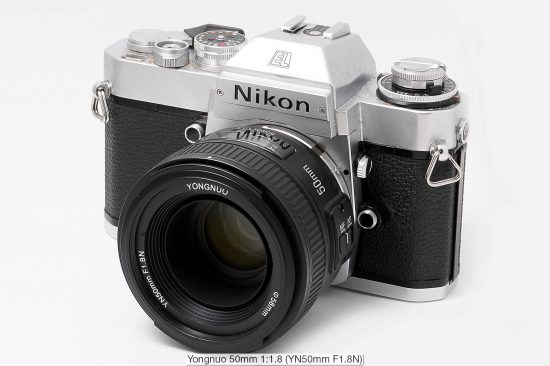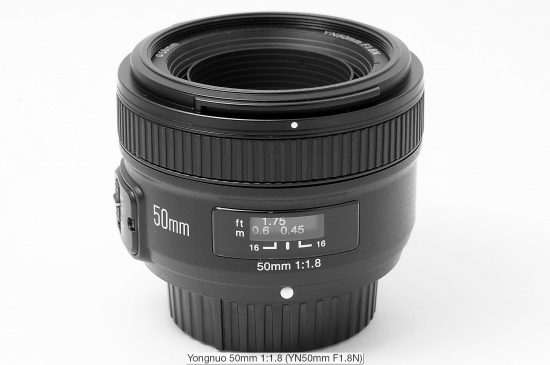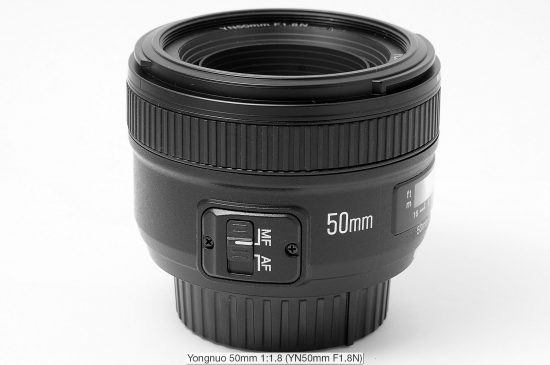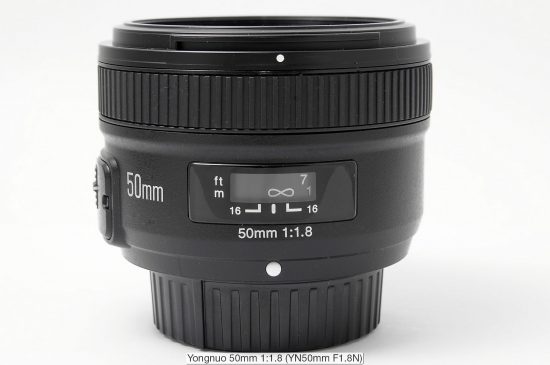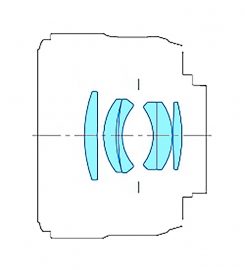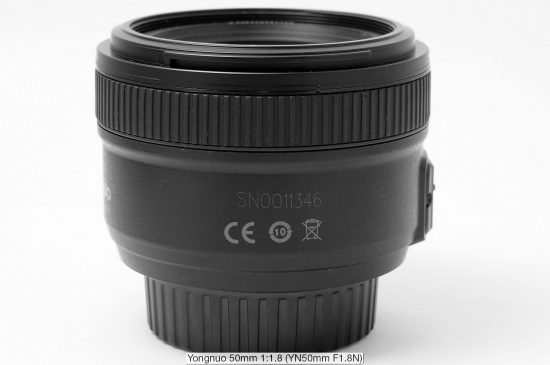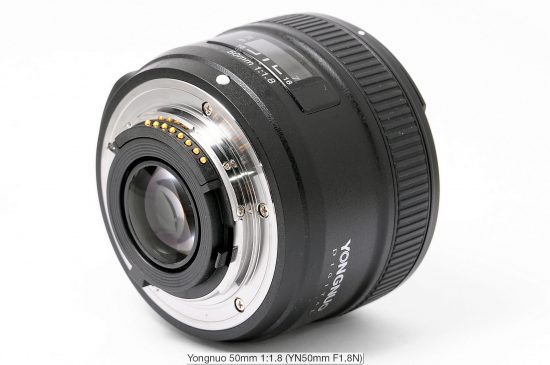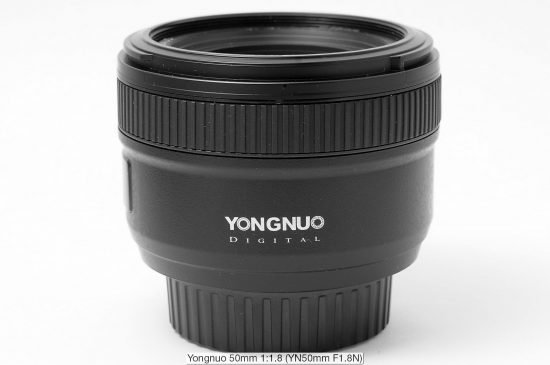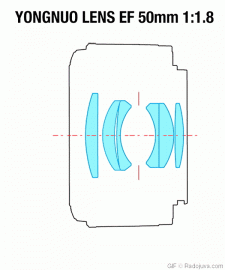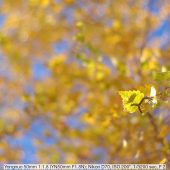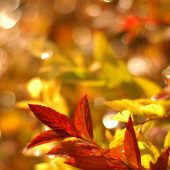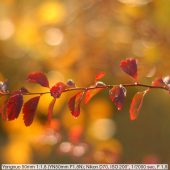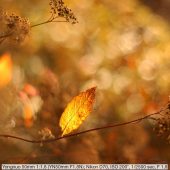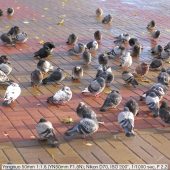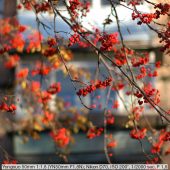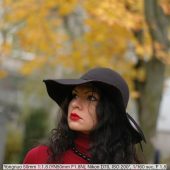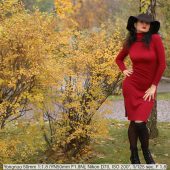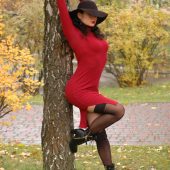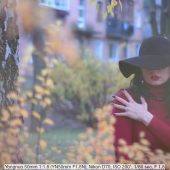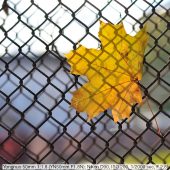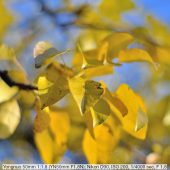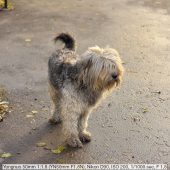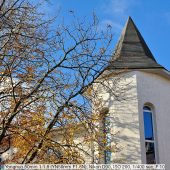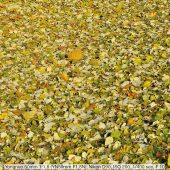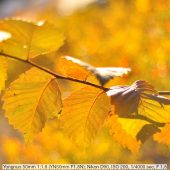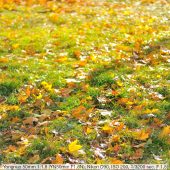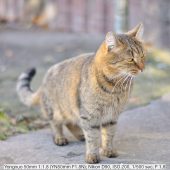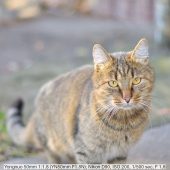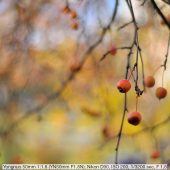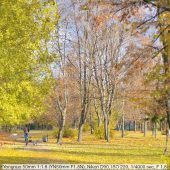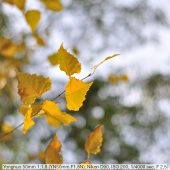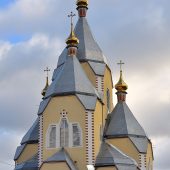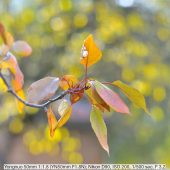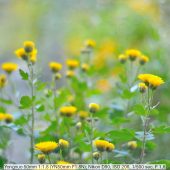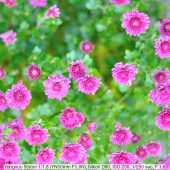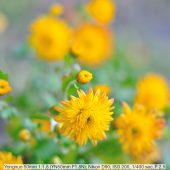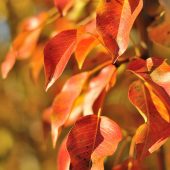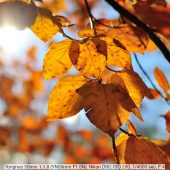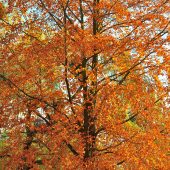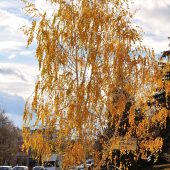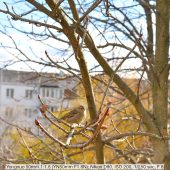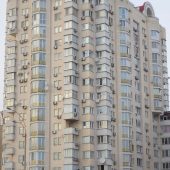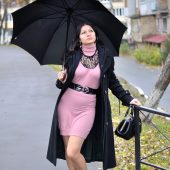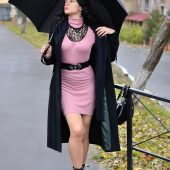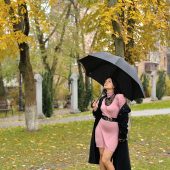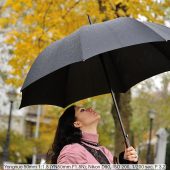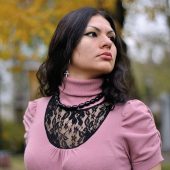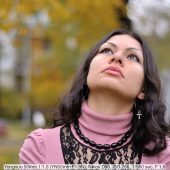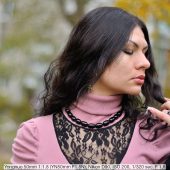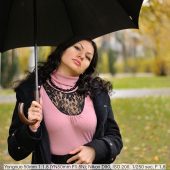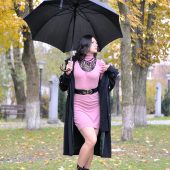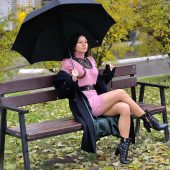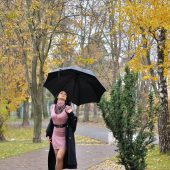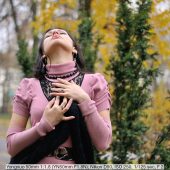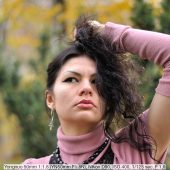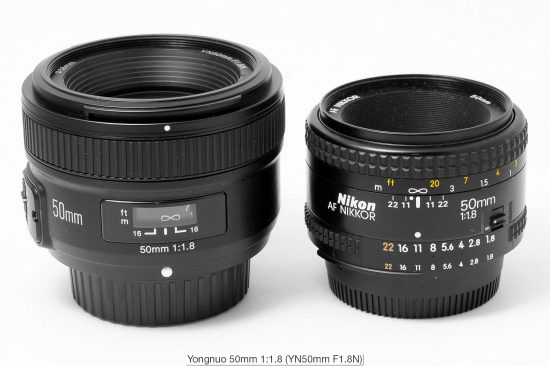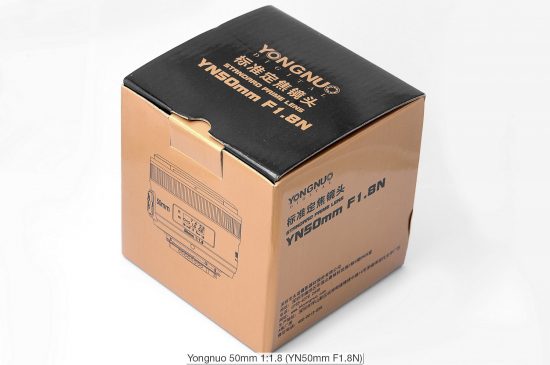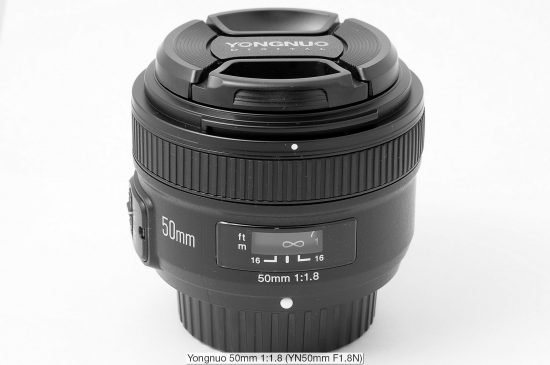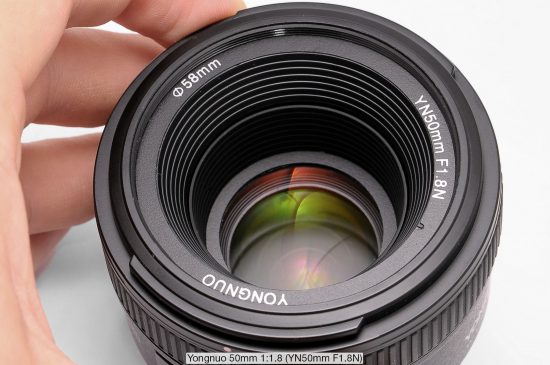
This review of the Yongnuo YN 50mm f/1.8 full frame lens for Nikon DSLR cameras (additional coverage of that lens can be found here) is by Arkadiy Shapoval from radojuva.com:
Important: Please note that the Yongnuo YN50mm F1.8 lens model, in versions for Nikon and Canon, looks very different from one another. Usually, third-party lenses such as Tokina, Tamron, Sigma, Carl Zeiss, etc., have a very similar barrel design for versions for different systems.
In brief
Yongnuo 50mm 1: 1.8 (YN50mm F1.8N) is a very inexpensive fast nifty fifty lens from the Chinese manufacturer Yongnuo Digital. The lens copied the original Nikon 50/1.8G barrel design and the optical performance of the Yongnuo Lens EF 50mm 1: 1.8. In general, it is not bad. First of all Yongnuo YN50mm F1.8N is interesting to owners of Nikon D40, D40x, D60, D3000, D3100, D3200, D3300, D3400, D5000, D5100, D5200, D5300, D5500, D5600. For those who have a Nikon camera with a built-in focus motor, there is a remarkable and inexpensive Nikon 50/. 1.8D (as well as a million of its old sub-versions).
The creative and practical potential of this 50 mm lens is difficult to overestimate. It is suitable for a wide range of photo tasks. Photographers often use it as a portrait lens. A lot of them just want a high-speed fix, in addition to their kit lens. The aperture F/1.8 is 3.5 stops wider than the aperture F/5.6, which is used in the ‘slow’ kit lenses at 50 mm. In a numerical equivalent, this means that the Yongnuo 50mm 1:1.8 (YN50mm F1.8N) is 10 times faster, for example than Nikon 18-55/3.5-5.6 kit lens (which uses a maximum relative aperture, equal to only 1:5.6, for 50 mm). Counting in the difference of the relative aperture is quite simple: (5.6*5.6)/(1.8*1.8) = 9.679, rounded to the value ’10’.
History
The first lens from the company Yongnuo Digital was a nifty fifty lens for Canon EOS cameras – Yongnuo Lens EF 50mm 1:1.8 (YN50mm F1.8), presented on December 27, 2014.
On July 10, 2015 Yongnuo AF-S 50mm 1:1.8 (AF-S 50mm 1.8, for Nikon cameras) was introduced in Shanghai. The lens had the inscription ‘AF-S’, and the DOF scale was for F/22. Near the filter thread was the designation ‘YONGNUO AF-S 50mm 1.8’, near the DOF scale was the designation ‘AF-S 50mm 1:1.8’.
On May 7, 2016 the lens ‘YONGNUO O58mm YN50mm F1.8’ (without the designation ‘AF-S’, without the designation ‘N’ and with the DOF scale for F/16) was on sale. Most likely Yongnuo AF-S 50mm 1:1.8 was just a prototype, its optical scheme and the type of focusing motor will remain unknown.
After some time, the letter ‘N’ was added to the lens name ñ YONGNUO O58mm YN50mm F1.8N. ‘N’ is an abbreviation for ‘Nikon’, after which the lens took on the form shown in this review.
All lenses of Yongnuo Digital
For Nikon DSLR:
- Yongnuo 35mm 1:2 (model YN35mm F2N)
- Yongnuo 50mm 1:1.8 (model YN50mm F1.8N)
- Yongnuo 50mm 1:1.8 (model YN50mm F1.8, without ‘N’, the same as previous)
- Yongnuo AF-S 50mm 1:1.8 (model AF-S 50mm 1.8, prototype)
For Canon EOS DSLR:
- Yongnuo Lens EF 35mm 1:2 Yongnuo Lens Made In China (model YN35mm F2)
- Yongnuo Lens EF 50mm 1:1.8 (model YN50mm F1.8)
- Yongnuo Lens EF 50mm 1:1.4 (model YN50mm F1.4, prototype)
- Yongnuo YN85mm F1.8 (model YN85mm F1.8)
- Yongnuo 100mm 1:2 (model YN100mm F2)
Teleconverter (only for Canon):
- Yongnuo Extender EF 2x III, Canon Extender EF 2x III copy
- Yongnuo Extender EF 1.4X III, Canon Extender EF 1.4X III copy. Same as Viltrox EXTENDER EF 1.4X
- Yongnuo YN C-AF 2x Teleconverter II, Kenko C-AF 2X TELEPLUS MC-7 copy. Same as Viltrox C-AF 2x TELEPLUS.
- There might also exist other models of teleconverters Yongnuo/Viltrox.
The Yongnuo Digital lenses copy the optical designs of the old Canon EOS lenses. Usually, first the version for Canon comes out, and after a while ñ for Nikon. Yongnuo does not produce lenses for other popular SLR systems (Pentax, Sony, Sigma, Micro 4/3). As for Yongnuo Digital teleconverters, now, they exist only for Canon EOS cameras.
The main technical characteristics of YONGNUO 50mm 1: 1.8 (YN50mm F1.8N):
| The name of the copy from the review | Near the front lens: YONGNUO O58mm YN50mm F1.8N. On the barrel: 50mm 1:1.8 SN0011346. On the box: YONGNUO DIGITAL YN50mm F1.8N standard prime lens |
| Basic characteristics |
|
| Filter thread | 58 mm, plastic thread |
| Focal length | 50 mm, equivalent focal length for Nikon DX cameras is 75 mm |
| Zoom | 1 X (this is a fixed lens, it does not have a zoom) |
| Made for | For Nikon full-frame digital cameras |
| Diaphragm blades | 7 rounded blades |
| Markings | Focusing distance in meters and feet, DOF for F/16 value, bayonet mount marking and lens hood mountings |
| Aperture | from F/1.8 to F/16, without an iris control ring, Nikon G lenses analogue |
| Minimum Focus Distance | 0.45 m, Maximum Reproduction Ratio – 1:6.7 |
| Weight | 203 g |
| Elements/Groups | 6 elements in 5 groups. The lens does not use special optical elements in its optical design.
Also, a similar optical design is used in lenses:
Optical scheme of the type of a double Gaussian lens (ie Planar). |
| Hood | Plastic, bayonet type. The model is unknown. Sometimes is not included. |
| Country of manufacture | The country of the manufacturer is not specified on the lens barring. But, in fact, the lens is made in China. |
| Period | On sale since May 7, 2016. The prototype was introduced on July 10, 2015 |
| User manual | View my scan |
| Price | Aliexpress link |
For some reason, I’ve seen very little information on the web on the Yongnuo 50mm lens for Nikon cameras, so I tried to add as much useful information on the YN50mm F1.8N in this review as possible.
Assembly
The lens I got for a review was almost new. Before sending it to me, the owner has been using it only for a few days.
In a small box are the warranty card, instruction in Chinese and English languages and the lens itself with the front (YN-58) and the back cap. The box is made in the golden coloration style of the Nikon Nikkor lenses. What this lens did not have was the protective film on the front and back lenses, which originally comes with the lens.
The lens is not bad. It’s nice that unlike the version of Yongnuo Lens of the EF 50mm 1:1.8, the Yongnuo YN50mm F1.8N version has a metallic bayonet mount.
The focus ring is rubberized. It is stated that the contacts of the microcircuits are gilded to improve the current flow.
Among the shortcomings, I would like to highlight:
- The focus ring has a slight backlash.
- If you press the diaphragm pin on the side of the bayonet (linkage lever to control the diaphragm), it will be obvious how the diaphragm blades not only close/open but also move back and forth towards the front or rear lens. In the other lenses, I did not observe such a loosening of the diaphragm mechanism. I cannot say how critical this behavior of the diaphragm mechanism is. During the actual photography, I had no problems with the diaphragm whatsoever. Of course, the mechanism of the diaphragm is rumored to be a weak link of this lens on the forums.
- Yongnuo YN50mm F1.8N weighs 20 grams heavier than the original Nikon 50/1.8G, from which the barrel design was copied (185 vs. 203 grams).
- Also, it is unfortunate that I did not find the lens hood in the delivery set. At the same time, some Yongnuo YN50mm F1.8N lenses come with a plastic hood bayonet type. It is unknown, why the lens hoods are not part of every YN50mm F1.8N lens kit.
- The camera lost contact with the lens several times during high-speed continuous shooting. To restore functionality, I had to detach the lens and reattach it to the camera. This situation occurred several times on different cameras, which indicates that the problem lies with the lens and not the cameras.
- Unlike the Nikon 50/1.8G, the Yongnuo YN50mm F1.8N does not have a dustproof and waterproof rubber lens mount seal.
- There is no country of manufacture label on the lens case. Of course, we all know perfectly well that the lens is made in China, but still, the lack of information on the product itself is a bit alarming.
The diameter of the front filter is 58 mm, the same diameter is used by Nikon 50/1.8G and many other lenses.
I want to note that Yongnuo YN50mm F1.8N (for Nikon cameras) is better manufactured in terms of quality than Yongnuo Lens EF 50mm 1:1.8 (for Canon cameras). Unlike the version for Canon cameras, it uses a metal bayonet, a virtually internal focus, has a window with a focusing distance, a DOF scale, a more thoughtful AF/MF switch and can use a bayonet-type hood.
Focusing
The lens has a built-in focus motor, so the Yongnuo YN50mm F1.8N will automatically focus on all Nikon digital SLR cameras, even on Nikon D40, D40x, D60, D3000, D3100, D3200, D3300, D3400, D5000, D5100, D5200, D5300, D5500, D5600.
To be extremely precise, the Yongnuo YN50mm F1.8N is the analogue of the Nikon AF-I series lenses. Unlike Nikon AF-S lenses that use Nikon SWM’s ultrasonic focusing motors, the old Nikon AF-I lenses use the built-in buzzing micro-focus motors.
When focusing, the motor is making noise. Strangely, but the noise level is much lower than that of the Yongnuo Lens EF 50mm 1:1.8 lens. It’s very good that the Yongnuo YN50mm F1.8N is noisier than the non-motor Nikon 50/1.8D. It is a pity though that it still cannot compare with a low level of noise from the ultrasonic motor Nikon 50 /1.8G.
The automatic focusing of the lens is fast enough. The autofocus speed is comparable to the Nikon 50/1.8G.
When used on a Nikon D90 camera (with a simple Multi-CAM 1000 focusing system), as well as on a Nikon D70 camera (with a super-simple Multi-CAM 900 focusing system), the lens behaves well and rarely has errors in focusing. I did not have any problems with precision and tenacity of focusing. In addition, I was pleasantly surprised by the quality of the focus. On the Nikon D90 I checked the presence of the back and front focus at different focusing distances (infinity and MFD including). As a measure, the photos were taken using the Live View mode (which does not suffer from the back/front focus). The accuracy of focusing using phase sensors completely coincided with the Live View mode.
I have a lot of experience with the Nikon 50 /1.8D lens. Therefore, I want to note that Yongnuo YN50mm F1.8N is not as confident as the original lens when it comes to focusing.
When focusing, the front lens group moves in the middle of the barrel frame. I can not say that the lens has an internal focusing. But, when focusing, the lens does not change its size. This type of focusing can be found in the Nikon 50/1.8G and Nikon 50/1.4G.
The focus ring is rubberized and rotates about 80 degrees. When the end positions are reached, the ring rests. The focus distance scale rotates in the opposite direction to the rotation of the focusing ring (this is the first I see!). Manual hitting is not very convenient. During manual focus, it is audible as ‘plastic rubs against plastic’.
The lens housing has a focus mode switch ‘AF/MF’ (auto focus / manual focus). During autofocus, the focus ring remains stationary, while it can be freely rotated 360 degrees without any effect on focusing.
The lens has a window with a focus distance scale in meters and feet, as well as a DOF scale for F/16. The minimum focusing distance is 45 cm, and the maximum magnification ratio is 1:6.7 (typical figures for similar nifty fifty lenses).
Other features:
- Yongnuo YN50mm F1.8N does not have any focusing problems in Live View mode (checked on Nikon D90).
- The lens transmits the value of the focusing distance to the subject in the camera (Nikon D, Nikon G analogue).
- Yongnuo YN50mm F1.8N has a not very pronounced ‘Focus Breathing’ effect (change of the viewing angle during focusing). During the focusing toward the MFD, the viewing angle decreases.
- The viewing angle of the Yongnuo YN50mm F1.8N is slightly wider than that of the Nikon 50/1.8D. It may seem that the focal length Yongnuo YN50mm F1.8N is closer to 45 mm.
- Focusing is performed by simultaneously moving the entire lens unit (all lenses) relative to the focal plane.
- Yongnuo YN50mm F1.8N does not have a hard stop (hard infinity mechanical stop), which allows you accurately and quickly focus the lens at infinity under any external temperature conditions. For accurate focusing to infinity, you cannot just bring the focus ring to its extreme position.
- Important: The YN50mm F1.8N has a small shift-focus. During the aperture, the exact focus moves away from the lens. The shift level is the same as for the Nikon 50/1.8D.
- Important: Yongnuo YN50mm F1.8N is a third-party lens. It may happen so that it will not work correctly with the new Nikon cameras, which will be presented after the announcement of this lens.
- Important: I have already seen some info on the web that the Yongnuo YN50mm F1.8N does not automatically focus with some Nikon cameras. I also ran into some reviews that Yongnuo YN50mm F1.8N may suffer from a strong twitching of the focus.
- Important: this particular copy suffers from a front-focus on the Nikon D40 camera, which is used by the owner of this lens (according to the owner).
- Compatibility with teleconverters is unknown.
- Compatibility with the FT-1 adapter for Nikon 1 system cameras is unknown.
To summarize, the focusing of the lens is all right, and well thought through design of the barrel and the ‘AF/MF’ switch make the YN50mm F1.8N more convenient to handle than the Nikon 50/1.8D.
Image quality
The color rendering is pleasant, in some ways even better than the original Nikon 50/1.8D. Also, I want to note that the lens coating of the versions Yongnuo Lens EF 50mm 1:1.8 and Yongnuo 50mm 1:1.8 (YN50mm F1.8N) visually differ a lot. Most likely, the version for Nikon uses a newer lens coating.
I could not leave out the chromatic aberrations. Particularly noticeable is green and violet contours of contrasting objects in the blur zone.
In the center of the frame, the lens is quite sharp already at F/1.8. Confident sharpness in the center of the frame comes with F/2.2-F/2.5. At the aperture of F/2.8, the lens in the center of the frame is very good. On full-size cameras, there will likely be a noticeable subsidence of sharpness in the corners and edges of the image.
The level of vignetting on APS-C cameras is small even at F/1.8. I did not have a light filter at 58 mm to check how much it could affect the vignetting.
The level of distortion is small.
The lens moves the backlight and side light well. The deep-set front lens contributes to that. The frame of the barrel works like a small lens hood. With the additional bayonet lens installed, the work in the direct sunlight should improve. It is quite difficult to achieve the effect of a 14-ray star from bright objects. Because of the rounded blades, the effect only occurs on heavily covered diaphragms, while the formed star is not very beautiful and poorly conveyed.
I want to highlight in bold that optically YN50mm F1.8N is not worse than the original Nikon 50/1.8D. Perhaps, laboratory tests could even show the superiority of the YN50mm F1.8N.
True, modern Nikon cameras can automatically correct some of the shortcomings of the Nikon 50/1.8D, such as vignetting, distortion, chromatic aberration, etc., in the case of the YN50mm F1.8N, you will have to use third-party software to remove distortions (or not use).
On the open diaphragms, bokeh of the lens is nothing special from the Nikon 50/1.8D and Canon 50/1.8 II. The reason is the same similar optical design. Below is a GIF animation of optical designs for six similar lenses:
Sample Photos
Snapshots with the Nikon D70. The photos are shown without processing, a camera JPEG. You can see the bokeh of the lens.
Download the source files by clicking on this link (56 original JPEG files).
Snapshots with the Nikon D90. The photos in the gallery are shown without processing, the original RAW-files are converted by the original Nikon ViewNX-i utility without making any additional adjustments.
Download the source files by clicking on this link (70 RAW files).
My Experience
The cheap 50 mm lens for Nikon non-motorized cameras is very good. Owners of cameras with a motor could always afford to buy a nice Nikon 50/1.8D for only 90-110 USD. However, the owners of non-motorized cameras had to buy a more expensive Nikon 50/1.8G (170-200 USD). With the introduction of Yongnuo 50mm 1:1.8, you can afford to buy a new nifty fifty lens with a built-in focus motor for 80 USD.
I treat the YN50mm F1.8N quite warmly and am glad that amateurs have the opportunity to buy a high speed 50 mm lens so cheap. In addition, I am glad that the YN50mm F1.8N is generally better than the Yongnuo Lens EF 50mm 1:1.8 for Canon. Only a pity that the version for Nikon is 1.5 times more expensive than the copy for Canon.
Important: this lens is primarily designed for amateur photographers (not professionals and not advanced amateurs!), who will take good care of their photo equipment and refrain from using it in conditions with a heavy load (weddings, reports, extreme conditions, etc.). I saw with my own eyes how my colleague, during the change of lenses, dropped the Nikon 50/1.8D from a meter height on the concrete floor. The lens received only a tiny scratch on the barrel, but it did not affect its functionality in any way. I do not think Yongnuo 50mm 1:1.8 will survive such a test.
Of course, the resilience of Yongnuo 50mm 1:1.8 is not comparable to the old manual lenses Nippon Kogaku Japan Nikkor-S Auto 1: 2 f = 5cm or Nikon Nikkor-S.C Auto 1: 1.4 f = 50mm. Nevertheless, for most tasks, I would prefer the presence of automatic focusing to a strong well-made barrel. Users leaning towards YN50mm F1.8N are often constrained in their means and are faced with the question: shall I choose ‘made in China’ or ‘Japanese manual’? I am often asked this question in pm. Usually my answer is that ‘made in China’, in general, is better for photography, while for video shooting (where automatic focusing is not so important) – any ‘Japanese manual’.
Summing up all my experience with the lens, here’s my brief recommendation: YN50mm F1.8N can be safely purchased for Nikon non-motorized cameras. For cameras with a built-in focus motor, it is better to take the original Nikon 50/1.8D (does not matter, used or new).
All autofocus Nikon 50/1.8 lenses
In 2017, Nikon has 5 autofocus class 50/1.8 lenses (but only with two fundamentally different optical designs):
- Nikon 50mm 1: 1.8 AF Nikkor (the first version, MK I, Non-D) ñ the lens was produced only in Japan from 1986 to 1990.
- Nikon 50mm 1: 1.8 AF Nikkor (second version, MK II, also known as ‘N’, or ‘NEW’ version, Non-D) – the lens was produced in Japan and China. The MK II version was produced from 1990 to 2001. There are three sub-types that do not differ in anything:
- MIJ (MADE IN JAPAN)
- NJ (NIKON JAPAN)
- MIC (MADE IN CHINA)
- Nikon 50mm 1: 1.8D AF Nikkor (the third version, MKIII, is more commonly known as the ‘D’-version) – the lens has been produced since 2002 to this day. All lenses are manufactured in China.
- Nikon AF-S Nikkor 50mm 1: 1.8G SWM Aspherical (the fourth version, MKIV, better known as the ‘G’-version or’ AF-S ‘version) – the lens has been produced since 2011, all lenses are produced in China.
- Nikon AF-S Nikkor 50mm 1: 1.8G SWM Aspherical Special Edition (the fifth version, MKV, is better known as the version of ‘Special Edition’ or ‘SE’ or the version for Nikon Df) – the lens has been released from the autumn of 2013. All lenses are manufactured in China.
I want to note that the versions of MKI, MKII, MKII use the same 6/5 optical design, similar to YN50mm F1.8N.
MKIV, MKV versions use a newer optical design 7/6.
The main differences between Yongnuo 50mm 1:1.8 (YN50mm F1.8N) and Nikon AF-S Nikkor 50mm 1:1.8G SWM Aspherical:
- The YN50mm F1.8N is a newer lens, introduced five years after the Nikon 50 / 1.8G.
- YN50mm F1.8N is 18 grams heavier than the Nikon 50/1.8G.
- Lens hood is not always included in the YN50mm F1.8N set.
- The Nikon 50/1.8G has a rubber lens mount seal that makes the mounting of the bayonet dust and waterproof.
- Lenses use different focusing motors. The YN50mm F1.8N uses a conventional micro motor, the Nikon 50/1.8G uses an ultrasonic Nikon SWM motor. The speed of focusing is practically the same.
- The Nikon 50/1.8G has the ability to continuously control the ‘M/A’ focus manually. For manual focus, the YN50mm F1.8N must be set to ‘MF’.
- Different optical designs. The Nikon 50/1.8G uses a more modern optical design incorporating one aspherical element, which allows for a better image, especially on open diaphragms.
- Modern Nikon cameras can automatically correct some distortions of the Nikon 50/1.8G lens. With YN50mm F1.8N, some image enhancement functions will not be available, since this lens is not in the memory of modern cameras.
- The cost of the new Nikon 50/1.8G is about 2-3 times higher than the cost of the new YN50mm F1.8N.
The main differences between Yongnuo 50mm 1:1.8 (YN50mm F1.8N) and Nikon 50mm 1:1.8D AF Nikkor:
- YN50mm F1.8N is a newer lens, introduced 14 years after the release of the Nikon 50/1.8D.
- Lenses use a completely different design of the barrels. Visually Nikon 50/1.8D is much smaller than YN50mm F1.8N.
- Nikon 50/1.8D is approximately 50 g lighter than YN50mm F1.8N.
- For focusing, the YN50mm F1.8N uses the built-in micro-focus motor. The Nikon 50/1.8D does not have a built-in focus motor and is focused by the focusing motor built into the camera. This is one of the main functional differences between lenses.
- Unlike the Nikon 50/1.8D, during focusing, the YN50mm F1.8N does not have an extension of the barrel.
- Modern Nikon cameras can automatically correct some distortions of the Nikon 50/1.8D lens. With YN50mm F1.8N, some image enhancement functions will not be available, since this lens is not in the memory of modern cameras.
- Nikon 50/1.8D has a diaphragm control ring that is not available for YN50mm F1.8N.
- The new Nikon 50 / 1.8D is slightly more expensive than the new YN50mm F1.8N.
To summarize, it turns out that Yongnuo 50mm 1:1.8 is a mixture of Nikon 50/1.8D and Nikon 50/1.8G. From Nikon 50/1.8G, it borrowed control and design of the barrel, while it copied the optical design from Nikon 50/1.8D. From the functionality point of view, Yongnuo 50mm 1:1.8 is still closer to the Nikon 50/1.8G.
Conclusion
Yongnuo 50mm 1:1.8 (YN50mm F1.8N) ñ is a cheap Nikon 50/1.8G analogue, with an optical design close to the Nikon 50/1.8D. However strange it may sound, the YN50mm F1.8N is a perfectly usable lens. Given the price/performance ratio, I recommend it to all amateur photographers who want to join the world of high-speed auto focus fixes.
The material prepared by Arkadiy Shapoval, author of radojuva.com.
If you have an interesting idea for a guest post, you can contact me here.
